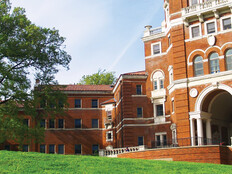Keep Wi-Fi 6 in Mind When Planning Network Upgrades
The next generation of Wi-Fi is on the horizon, with big implications for higher education. It’s designed for the type of high-density environments that shine on campus — think lecture halls and sports stadiums — but can put on a strain on current networks. Here are five things you need to know.
1. Wi-Fi 6 Is Designed for High-Density Environments
Wi-Fi 6 isn’t just a step up in speed from Wi-Fi 5. The goal is to boost performance in densely populated areas — that is, when both clients and access points play by Wi-Fi 6 rules.
The nomenclature reflects the Wi-Fi Alliance’s attempt to add clarity to the IEEE numbering scheme (such as 802.11n) by assigning its own names. Each new Wi-Fi number builds on the one before, with Wi-Fi 6 (based on IEEE 802.11ax) focused on environments such as classrooms and stadiums. Wi-Fi 5, the IEEE 802.11ac standard approved in 2013, is now widely deployed and should coexist well as Wi-Fi 6 debuts.
2. Compatible Products Are Appearing in the Market
The standard still isn’t fully approved, but every major Wi-Fi infrastructure vendor has already announced products. Most of the action has been over the past 12 months, so expect to see more activity. On the client side, the Samsung Galaxy S10 and the Apple iPhone 11 family of devices are the first to support it. Laptops based on Intel Ice Lake and Comet Lake CPUs should be firmware-upgradeable to support 802.11ax.
3. Wi-Fi 6 Improves on Both Performance and Security
Older devices should work fine on Wi-Fi 6 networks, but without new clients, you won’t see any advantage. The biggest jump will be in high-density spaces, but these features require both clients and APs to be Wi-Fi 6. As long as you have old stuff on the airwaves, you’ll see no or limited benefits.
Wi-Fi 6 does require the new WPA3 encryption and authentication protocol (the latest version of Wi-Fi Protected Access), which gives stronger security to any client with modern firmware.
READ MORE: Discover how 5G is opening new doors for education technology in higher education.
4. Wi-Fi 6 and 5G Complement Each Other
Wi-Fi 6, with higher speed and density, extends the usefulness of Wi-Fi as a faster, better, cheaper alternative to cellular data, even the superhigh speeds proposed for 5G networks. This reflects both technical advances and a strong consumer preference for Wi-Fi.
Wi-Fi 6 also opens up more frequencies, subject to regulatory approval in each country. The result is that IT managers should keep planning for Wi-Fi support. Users will get a better experience with properly engineered and deployed Wi-Fi 6 than with 5G. That said, the two are complementary, with Wi-Fi ideal for indoor areas and 5G the standard of choice for outdoor networks.
5. Design a Phased-In Approach to Wi-Fi 6 Upgrades
A full Wi-Fi 6 deployment means swapping out APs, clients and network infrastructure. A 1-gigabit link isn’t fast enough to feed a high-speed, high-density Wi-Fi 6 AP. That’s a big step. Instead, IT managers should look for a gradual upgrade path, making sure that anything they add to their networks now can support Wi-Fi 6 and looking at how to accommodate faster AP-to-network speeds in the next upgrade cycle.









